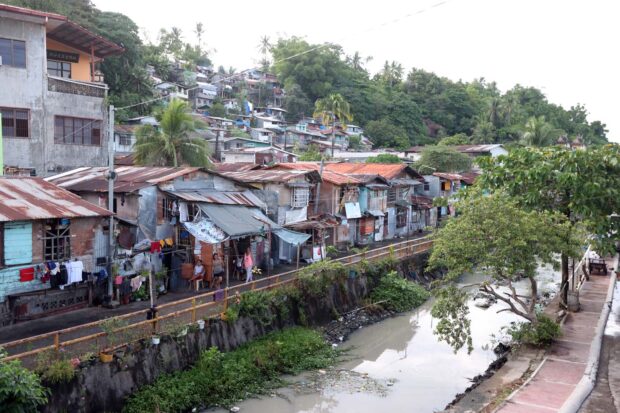Poverty incidence in Eastern Visayas drops by 1.8 percent

HOME BY THE CREEK T| he National Economic and Development Authority has reported a slight drop in poverty incidence in Eastern Visayas although there are still localities in the region, including the regional capital Tacloban City, where the living conditions of the poor have yet to improve. This photo taken on Monday shows a depressed area in Anibong District, Tacloban City. (Photo by NIÑO JESUS ORBETA / Philippine Daily Inquirer)
TACLOBAN CITY, Leyte, Philippines — The National Economic and Development Authority in Eastern Visayas (Neda-8) has announced a slight reduction in the poverty incidence in the region. From 30.7 percent in 2018, the number of poor persons in the region went down to 28.9 percent based on a 2021 full report.
Meylene Rosales, Neda-8 regional director, said this meant that 31,200 people were “lifted from poverty” in a span of three years, a significant number given that the country’s poorest province is found in Eastern Visayas.
“With the 28.9-percent poverty incidence among the population, we actually missed our target of 23.7 percent for the same year as indicated in our Eastern Visayas Regional Development Plan. This is understandable because of the economic slump we suffered from due to the COVID-19 pandemic,” Rosales said in a statement on Monday.
“However, it is still worth noting that 31,200 more people in Region 8 have been lifted out of poverty from 2018 to 2021,” she added.
Poverty ranking
Rosales said in the last seven years, the region’s poverty ranking among the 17 regions in the country has also been improving.
Article continues after this advertisementThe region, inhabited by more than 4 million people, was the second poorest in 2015 and landed in third spot in 2018.
Article continues after this advertisementIn 2021, Eastern Visayas, composed of the provinces of Leyte, Southern Leyte, Biliran, Samar, Eastern Samar, and Northern Samar, ranked fifth on the poverty ladder, with the Samar provinces among the country’s poorest.
While the provinces of Eastern Samar, Northern Samar, Southern Leyte, and Leyte managed to reduce their poverty incidence, Rosales said the provinces of Samar and Biliran and Tacloban City, the regional capital, failed to report a decline in their poverty incidence.
“Notwithstanding this headway, we should not rest on our laurels. There is still no place for complacency. We must sustain this poverty reduction by increasing income opportunities for every family in Eastern Visayas—even when we are still grappling with this pandemic,” she said.
Gradual recovery
Rosales said that generally, the economy of the region is “gradually recovering” in the aftermath of the impacts of the COVID-19 pandemic as evidenced by a 6-percent growth in the gross regional domestic product in 2021 from 2020, the first year of the pandemic.
“We are now on our road to recovery. Fully reopening our economy will lead to more operational businesses that can provide jobs and income to households, thereby contributing to poverty reduction. We aim to transform our production sectors so that they generate more and better quality job opportunities,” she said.
Rosales added: “We need to attract more investments to the region. We need to bring down our power rates, guarantee an efficient water supply system that can feed our households and business establishments, ascertain that the Anti-Red Tape Act and the Ease of Doing Business Act are followed so that investors are not discouraged to spend money on new business in this part of the country just because it takes forever before they can be given a license to operate.”
Subsistence among the population in Eastern Visayas in 2021 was pegged at 10.4 percent, or about 10 in every 100 individuals in the region have income below the food threshold or the amount needed to buy their basic food needs.
A family of five in the region needed at least P7,819 per month to meet the family’s basic food needs, which satisfies the nutritional requirements for “economically necessary and socially desirable physical activities.”
To satisfy the basic food and nonfood requirements, a family of five needs P11,187 every month.
An increase in the prices of basic goods and services has increased the monthly income requirement from P10,411 in 2018.
The 2021 poverty incidence result was derived from the Family Income and Expenditure Survey which provides data on levels of consumption by item of expenditure, as well as sources of income in cash and in kind, the Neda said.